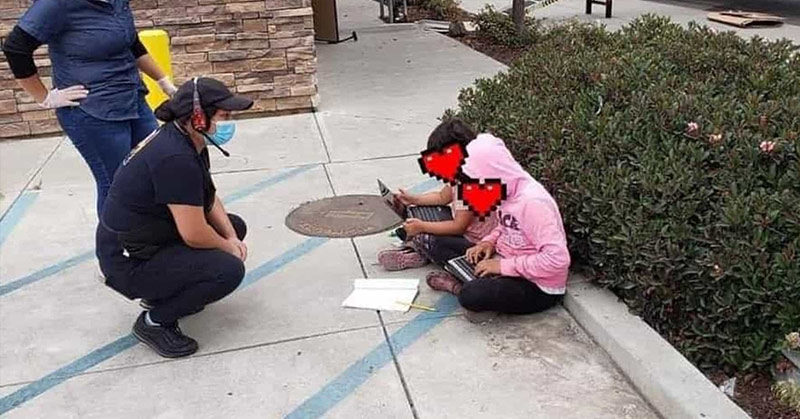When the COVID-19 pandemic began, schools across the country close their doors and students had to finish their school year online. Over the summer, the situation did not improve.
As kids return to school this fall, they are yet again having to use online distance learning to “go to school”. While this may work for children who have access to a computer and a strong wifi connection, there are thousands who are not so fortunate.
According to an analysis from July 2020, 16.9 million children in the United States do not have access to high-speed internet at home. 7.3 million children do not have a desktop, laptop, or tablet [1].
For these children, attending classes online is nearly impossible. This creates what is known as the “digital divide”. Students from wealthier families have the resources to keep up with their studies, while the others are at risk of falling behind.
This divide was exemplified a couple of weeks ago, when a photo of two young girls sitting outside a Taco Bell went viral.
Taco Bell Wifi
The photo showed two young girls in Salinas City, California, sitting on the pavement outside a Taco Bell doing their schoolwork. They were using the restaurant’s wifi, because they did not have a strong enough connection at home.
The photo, which highlighted the disadvantages many low-income families face with online learning, quickly made its rounds on the internet. California Senate President Kevin de Leon posted the photo on Twitter with the following caption:
“Two students sit outside a Taco Bell to use Wi-Fi so they can ‘go to school’ online. This is California, home to Silicon Valley…but where the digital divide is as deep as ever. Where 40% of all Latinos don’t have internet access. This generation deserves better.” [2].
Amy Ish, president of the Salinas City Elementary School District’s board of education commented on the situation, saying the digital divide is “very real”. She notes that delays in receiving needed technology are a concern across the entire state.
“We are grateful the state is making technology a priority and look forward to receiving these hotspots in our district,” she added [3].
The Digital Divide
This digital divide is making headlines now, but the reality is that it existed long before the COVID-19 pandemic began. This divide disproportionately affects students of color, low-income students, and families living in rural areas.
One in three Black, Latino, and American Indian/Alaska Native families do not have high-speed internet at home. One in three families who earn less than fifty thousand dollars per year are also without reliable internet. Two in five rural families face the same issue [1].
So far, the job of providing students with the necessary tools and internet access has fallen on the school districts. Schools are trying to give students and families access to internet hotspots, tablets, and laptops to use at home. Experts, however, are arguing that this is only a short-term solution to a much larger problem.
In a report for The Atlantic, Olga Khazan made the following statement:
“Experts and former Federal Communications Commission officials describe a federal government that has neglected to treat broadband as a public utility, instead relying on the largely self-regulated internet industry to provide service wherever it wanted, for the price of its choosing.” [4]
She added that the United States government has not regarded fast internet as something everyone should have, like water or phone service. The consequences of this have been a problem for years, but the coronavirus has highlighted them in a stark way.
A Helping Hand
Upon seeing the photo of the two girls, a local woman named Jackie Lopez tracked down their mother, wanting to help. She learned that they were sharing a bedroom with their mom and one other sister, and did not even have a space for a proper desk.
The girls’ mother, Juana, is a migrant worker. At the time of the photo, she was facing eviction from her rented room. Lopez started a GoFundMe page to help, which has now raised over 130 thousand dollars for the family. They are now working with an accountant to help them manage their funds.
“All children deserve a happy place to live and because of their dedication, these little girls deserve a safe space to learn,” Lopez wrote. “We appreciate every single one of you for helping making that happen.” [5]
This is a beautiful story of altruism and human kindness. The sad reality is that there are thousands of other children across the country facing similar situations. As the COVID-19 pandemic continues, there is no way of knowing when students will be able to return to school, and many of them are at risk of falling behind.
The authors of the July analysis concluded their report with the following statement:
“There are many unanswered questions about the 2020–2021 school year, yet one thing is certain: many students will receive their education online. Therefore, students without high-speed home internet will be severely disadvantaged. The gap between students who are “logged in” and “logged out” could set back a generation of American students. Thankfully, this is a solvable problem. By appropriating $6.8 billion in the next COVID-19 legislative package, Congress can provide the nation’s students with the tools they need and deserve to receive an excellent education.” [1]
- https://futureready.org/wp-content/uploads/2020/07/HomeworkGap_FINAL7.20.2020.pdf
- https://thehill.com/blogs/blog-briefing-room/news/514905-viral-photo-of-girls-using-taco-bell-wifi-to-do-homework
- https://www.nbcnews.com/news/latino/more-100k-raised-girls-who-needed-taco-bell-wifi-do-n1238939
- https://www.theatlantic.com/technology/archive/2020/08/virtual-learning-when-you-dont-have-internet/615322/
- https://www.usatoday.com/story/news/nation/2020/09/01/thousands-raised-girls-who-had-use-taco-bell-wifi-school/5680992002/

